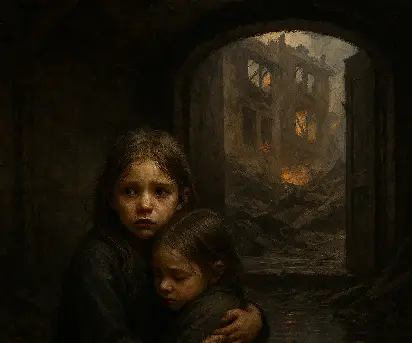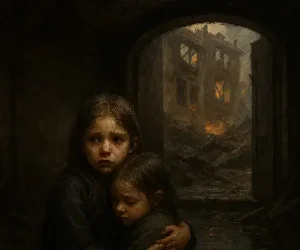
When Family Fails: The Emotional Cost of Parental Alienation and Abandonment
They are very important, right? Those first relationships we build—with our parents, our family. They’re important because they shape how we see ourselves and the world.

In the ruins of war, a child finds not toys or comfort—but severed heads and starvation. This is not fiction—it’s lived truth. They are very important, right? The childhood years. We think of them as sacred—a time for joy, safety, and carefree adventures. But what happens when childhood is stolen by war? When innocence is replaced by survival, and games are swapped for air raids, hunger, and fear? A Mother’s Final Letter is not a typical war story. It’s a window into the mind of a child who had to grow up in a world where bombs fell from the sky, food was a luxury, and death lived around every corner. This book is for those who want to understand war beyond headlines and history books. It’s for anyone who wants to feel the truth of what war does to the human spirit—especially the spirit of a child.
At the heart of the book is the powerful story of the author’s mother, who lived through World War II in Hamburg, Germany. She was just nine years old when the fire-bombing began. Most war books tell you what happened—A Mother’s Final Letter shows you how it felt. And one of the most unforgettable parts of the story is the chilling reality of what children saw, felt, and survived while the world around them burned. As a young girl, she would sleep fully dressed, ready to flee at the sound of sirens. When the bombers came, she’d run down five flights of stairs to hide in a cellar, which was nothing more than a regular basement—not a bunker. She describes the fear of complete darkness, the shaking of the walls as bombs exploded nearby, and the sound of adults praying, crying, and whispering commands to stay quiet. It wasn’t just the noise that terrified her—it was the silence before the bombs. That eerie calm that warned something terrible was coming.But it wasn’t just one night. This wasn’t a moment. This was her life for years.
In one unforgettable scene, after surviving yet another bombing, she walks out of the shelter and sees an apartment building destroyed. The front wall gone, exposing bathtubs hanging in the air, beds barely holding on to broken floors, and people crying in pain. Her mother is burned by falling phosphor. They lose their home and flee to live with relatives. And yet—this was just the beginning. You might think things got better when she was sent to her grandmother’s house in Goettingen, a quieter town away from Hamburg. But what happened there only adds to the haunting reality of her childhood. In one chilling chapter, she recalls sneaking to a bombed building with friends to explore. What they find is not rubble or ruins—but a preserved head. Yes, a human head. It belonged to a serial killer named Harrmann, and it had been kept in formaldehyde. This head—and several others—were just lying there after the building was destroyed. The kids opened the trunk, touched the heads, and stared into the empty eyes of horror. What kind of world creates memories like this for a child?
A Mother’s Final Letter isn’t just about bombs and fear—it’s about the thousands of little ways that war takes childhood and crushes it. It’s about trading bed sheets for potatoes. It’s about brushing your teeth with salt because there’s no soap. It’s about going to bed hungry and dreaming of food, and then waking up in a cold house with broken windows. It’s about being told to sit in a ditch in the woods instead of a classroom. The author’s mother shares stories of trying to have a normal life—roller skating with friends, writing plays, and going to a secret garden—but always with the shadow of war above her.
Perhaps the most powerful part of this story is not just what happened during the war, but what happened after. War doesn’t end when the fighting stops. The trauma stays. When she eventually moves to the U.S., her life continues to spiral through hardship. From abusive marriages to abandonment, to watching her own children get placed into foster care and adoption, the pain repeats itself in new forms. One generation’s trauma becomes the foundation for the next. But this book is not about giving up. It’s about witnessing. It’s about being strong enough to remember the hard parts, to write them down, and to share them with the world so we never forget what children suffer in silence. The author carefully fuses his mother’s original letter and her manuscript with his own memories and experiences, creating a layered story that goes far beyond one lifetime. It’s a story that shows how history and personal pain are connected—and how remembering is a form of healing.
So if you’re someone who wants to understand the true cost of war, not through maps and military tactics, but through the eyes of a child clutching her sister in a flooded basement—this book is for you. If you want to know what resilience looks like when it’s covered in dust and fear, if you want to know how strength is built out of heartbreak and hunger, A Mother’s Final Letter is the book you need to read. Because some stories must be told—not just remembered, but felt.

They are very important, right? Those first relationships we build—with our parents, our family. They’re important because they shape how we see ourselves and the world.

In the ruins of war, a child finds not toys or comfort—but severed heads and starvation. This is not fiction—it’s lived truth. They are very important, right? The childhood years.